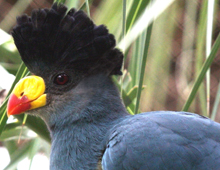Description: The turquoise-blue head of the Great blue turaco sports a bluish-black crest on the forecrown and crown. The bright yellow red-tipped bill is large and convex. Bare dark turquoise-blue eye-rings surround the reddish-brown eyes. The cheeks, throat and chin are gray. The upperparts, including wings and tail are turquoise-blue, as are the neck and upper breast on the underparts. There is a wide, black band near the end of the long, wide tail. Greenish-yellow adds to the color of the bird on the lower breast and belly with color changing to reddish-brown on the lower belly, undertail coverts and above the upper legs. The legs and feet are blackish. Sexes are similar.
Size: The Great blue turaco is the largest species in the Musophagidae family. They typically are 28- 30 inches (70-76 cm) in length; weight is between 1.8-2.7 pounds (0.8-1.2 kg). Males are slightly smaller.
Behavior: Territories are maintained throughout the year. Like many of the turacos, Great blues are rather shy and seldom descend to the ground except for drinking and bathing. They are quite agile when climbing throughout the branches. Seldom alone, they may be in pairs, family or social groups of up to seven individuals, with several groups often gathering at a single large fruit tree. These turacos are not good fliers, flying short distances and soaring to lower levels of the forest. Courtship involves calling, chasing, feeding each other, raising the crest and the long tail.
Diet: Great blue turacos forage for most of the day, particularly in the evening (may not feed during the hottest portion of the day). They primarily eat fruits but also feed on leaves, flowers, buds, shoots and insects.
Communication: Like most turacos, Great blues are quite vocal, having a deep gutteral sound that alternates with a softer trill. These vocalizations are frequently heard at dusk and dawn and are an important part of their courting displays.
Reproduction: Both parents build a stick nest in a tall tree in which two round, pale blue eggs are laid. The eggs are incubated by both parents for up to 31 days, with chicks being cared for by parents and sometimes an additional helper. After hatching, chicks leave the nest within six weeks but are watched over by the parents for up to three months.
Habitat/range: The Great blue is the most widely distributed of all turacos. They are found in the canopy, trees in secondary growth, forests and forest patches in humid, montane and savanna areas with a broad range in the forests of West and Central Africa.
Status: Listed as Least Concern by IUCN.



